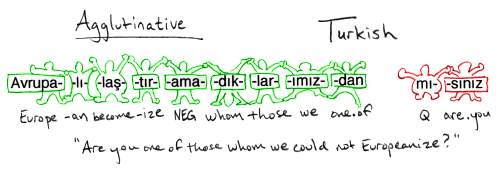Cartoon Theories of Linguistics
Part 3—Morphological Typology
Phineas Q. Phlogiston, Ph.D.
Unintentional University of Lghtnbrgstn
No need for an introduction, it was covered in previous installments (on non-configurational languages and ergativity).
Instead, let us proceed to the next chapter of our Cartoon Theories of Linguistics. I have provided the following cartoonish exegesis of morphological typology for your edification:




Up next: Statistical Machine Translation.
References

D with Upper-left Hook
|
|
|
- Baker, Mark. (1988). Incorporation: A theory of grammatical function changing.
- Baker, Mark. (1996). The polysynthesis parameter.
- Comrie, Bernard. (1989). Language universals and linguistic typology (2nd ed.).
- DeFrancis, John. (1990). The Chinese Language: Fact and Fantasy.
- Evans, Nicholas, & Sasse, Hans-Jürgen. (2002). Problems of polysynthesis.
- Eyuboğlu, İsmet Zeki (1991). Türk Dilinin Etimoloji Sözlüşü.
- Lewis, Geoffrey. (2001). Turkish Grammar.
- Payne, Thomas E. (1997). Describing morphosyntax: A guide for field linguists.
- Penny, Ralph. (1991). A History of the Spanish Language.
- Püsküllüoğlu, Ali. (2004). Arkadaş Türkçe Sözlük.
- Skorik, P. Ja. (1961). Grammatika čukotskogo jazyka: Fonetika i morfologija imennyx častej reči (Vol. 1, p. 102).
- von Humboldt, Wilhelm. (1836). Über die Verschiedenheit des menschichen Sprachbaues und ihren Einfluß auf die geistige Entwicklung des Menschengeschlechts. Berlin: Königliche Akadamie der Wissenschaften.



